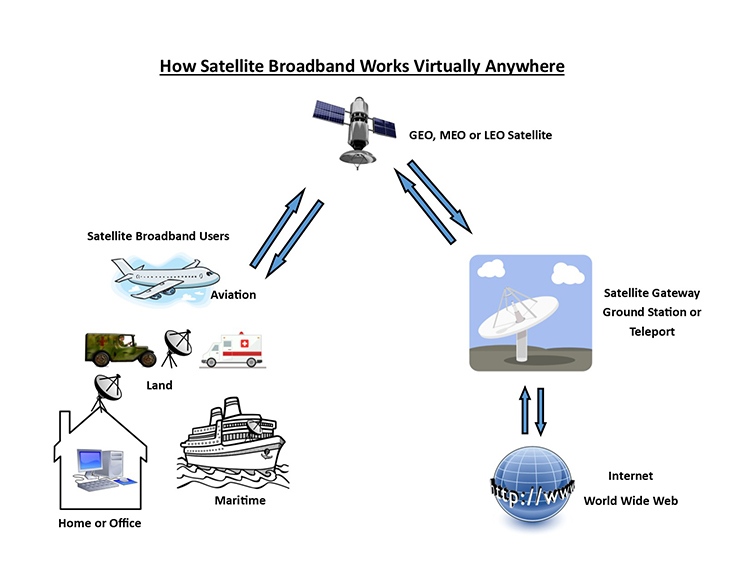Satellite communications services are capable of providing broadband connectivity to rural and remote areas of the country where it remains uneconomical for terrestrial services to deploy and provide both speeds and prices comparable to terrestrial alternatives. These services are available directly to the consumer today, covering all 50 states and delivering broadband offerings of up to 220 megabits per second (Mbps) or more to millions of customers nationwide. Satellite broadband is also used by business and government enterprises, for both fixed and mobile purposes, using a range of spectral bands to deliver assured access to broadband communications. Further, satellites are providing critical backhaul Internet connectivity to local Internet Service Providers and community institutions in remote locations.
Commercial satellite operators, that have already invested billions of dollars in the construction and deployment of geostationary (GEO) high throughput satellites, offer service to consumers today, no matter where they are located. These high throughput satellites, rely on frequency re-use and spot beam technology to produce increased output factors upward of 20 times that of traditional satellites. In the past five years, innovative new medium-Earth-orbit (MEO) and low-Earth-orbit (LEO) satellite data constellations have also been launched. By the end of 2023, satellite providers offered data speeds ranging from 25 Mbps to 220 Mbps. The industry has seen similar increases in the capacity of its systems. The first broadband satellite began service in 2008 with a capacity of 10 gigabits per second (Gbps); 2019 satellites have capacities of up to 260 Gbps, a number expected to increase to 1 Terabit per second or 1Tbps in 2023. These terabit capacity geostationary satellites will provide orders of magnitude capacity increases and resulting consumer broadband benefits, remaining competitive with terrestrial offerings.
In addition to these GEO innovations, several companies have already launched or have plans to launch thousands of new high throughput (non-geostationary) satellites in Low-Earth and Medium-Earth orbits to provide high-speed broadband at low latency levels. Launch, deployment and service offerings of the first of these operational networks has already begun.
Who Uses Satellite Broadband
Because satellites have the unique ability to offer virtually ubiquitous coverage for data communications, especially for customers in areas far beyond the reach of terrestrial mobile networks, many service providers use communications satellites to provide high speed broadband services to help bridge the “Digital Divide”.
Satellites can also provide:
- Vital broadband services for those in underserved rural markets
- Competitive broadband services for those already served by terrestrial data services
- Maritime broadband for cruise ship passengers and crews on various ocean going vessels
- In-flight connectivity (IFC) broadband services for commercial and government aircraft passengers and crew
Satellite Broadband for Emergency Responders
Following a natural disaster, emergency responders also use satellite broadband services when terrestrial networks have been damaged or destroyed. Unlike its terrestrial counterparts, satellite broadband networks are not susceptible to damage from such disasters because the primary repeaters are on board the spacecraft and not part of the ground infrastructure. Hand-held terminals, portable Very Small Aperture Terminal (VSAT) antennas, and temporary fixed installations can all be introduced into a post-disaster environment to provide support to relief efforts and enhance recovery efforts. For more information regarding the role satellites can play before, during and after a natural disaster, please visit the SIA Emergency Response and Disaster Relief page HERE.

Satellites and 5G
Today, existing high throughput GEO, MEO and LEO satellites support the delivery of data connectivity services, as well as enable global machine-to-machine communications. Fifth-generation and sixth-generation (5G and 6G) are the next generations of connectivity and the next leap forward for both terrestrial mobile and satellite telecommunications.
Access to high speed data broadband connectivity is vital for economic development. So as the world rolls out the next wave of mobile data services, there is a vital reality that still must be addressed. There are still more than 3 billion of the world’s population who are not connected to the internet. In the United States, regulators estimate that 21-30 million Americans living in rural communities still do not have access to terrestrial digital connectivity.
Satellites are helping to address this reality. Tremendous satellite industry innovations are happening today with high throughput satellites (HTS), lower cost high production manufacturing of smaller satellites, plus multiple plans for deployment of new powerful high-speed data geostationary (GEO) satellites, medium-earth-orbit (MEO) and low-earth-orbit (LEO) constellations. Thanks to these leaps in innovation, the satellite broadband industry is now seen as an effective and powerful tool that will not only help bridge the gap between those with and those without broadband connectivity, but satellite broadband is now seen as an integral part of the rollout of 5G and future 6G services. Therefore, future satellite fleets will help bridge the digital divide and will be a part of a system architecture that delivers broadband, IoT, and intelligent, connected transportation services to consumers.
